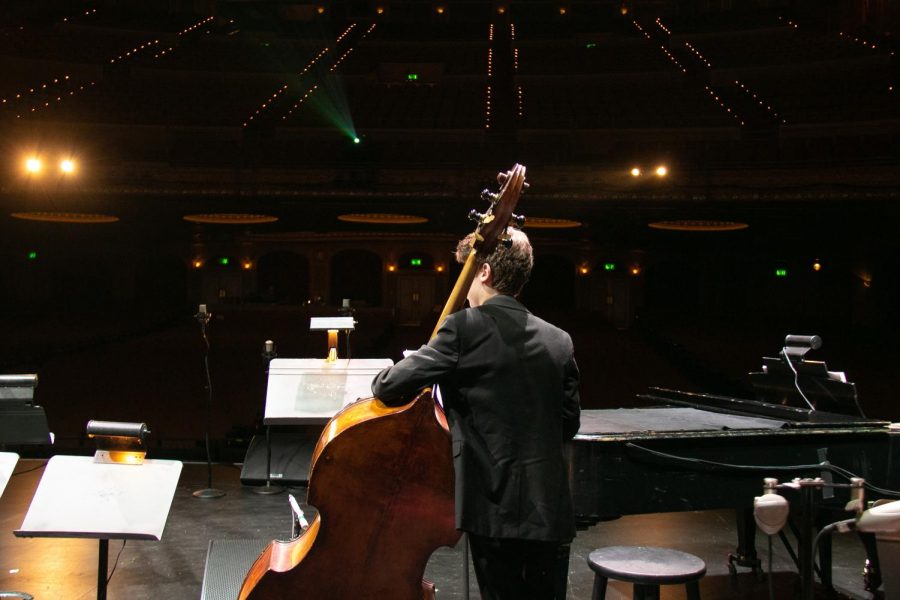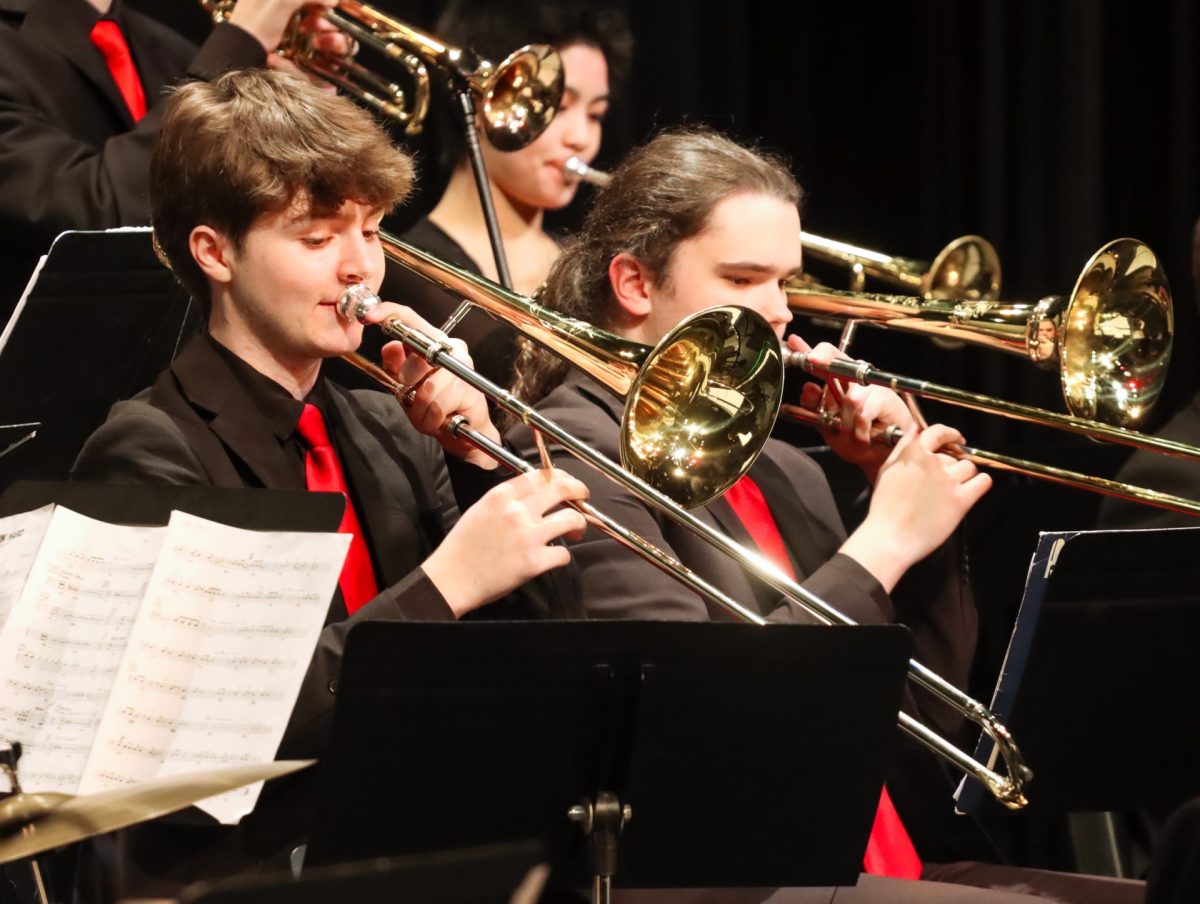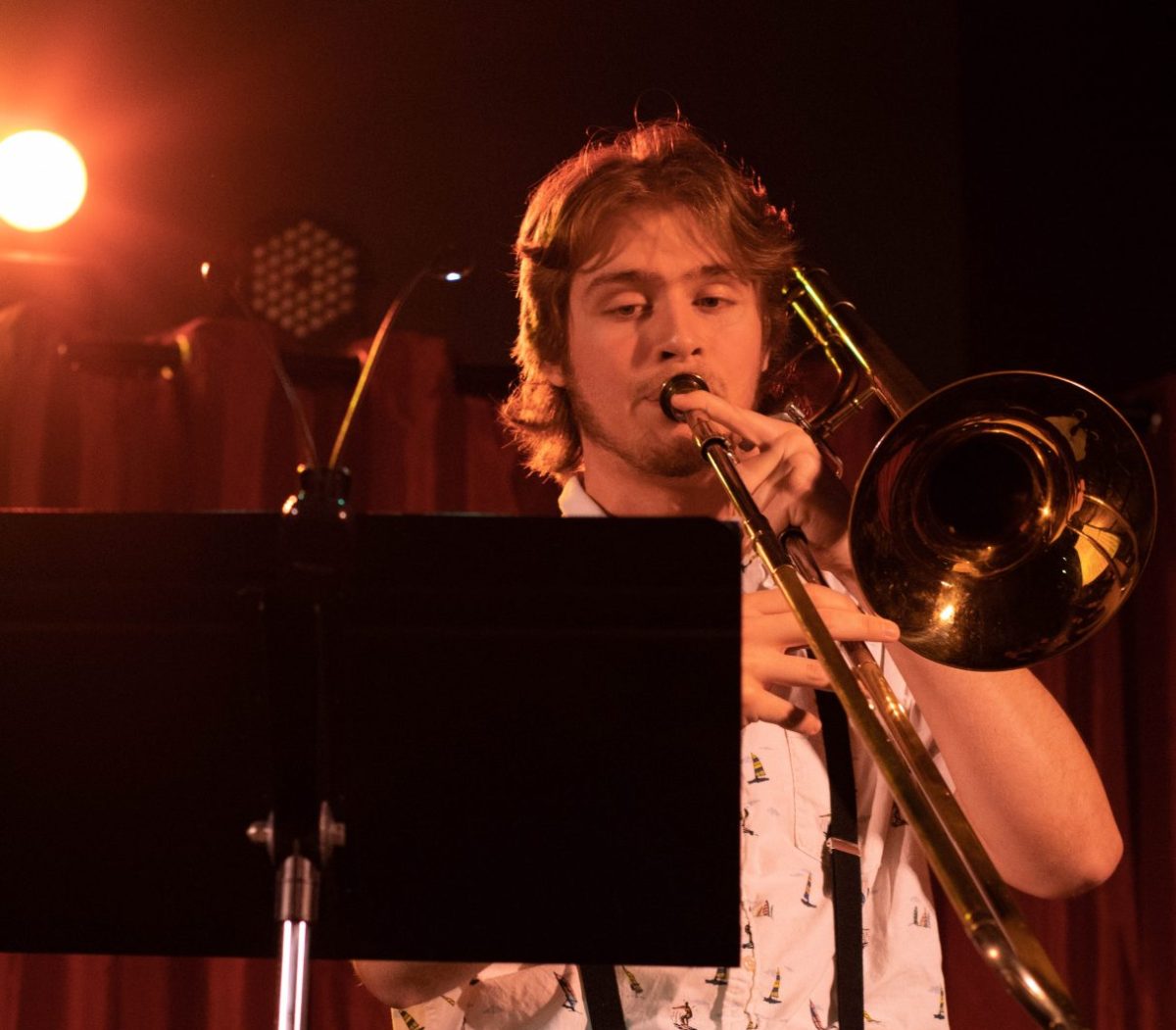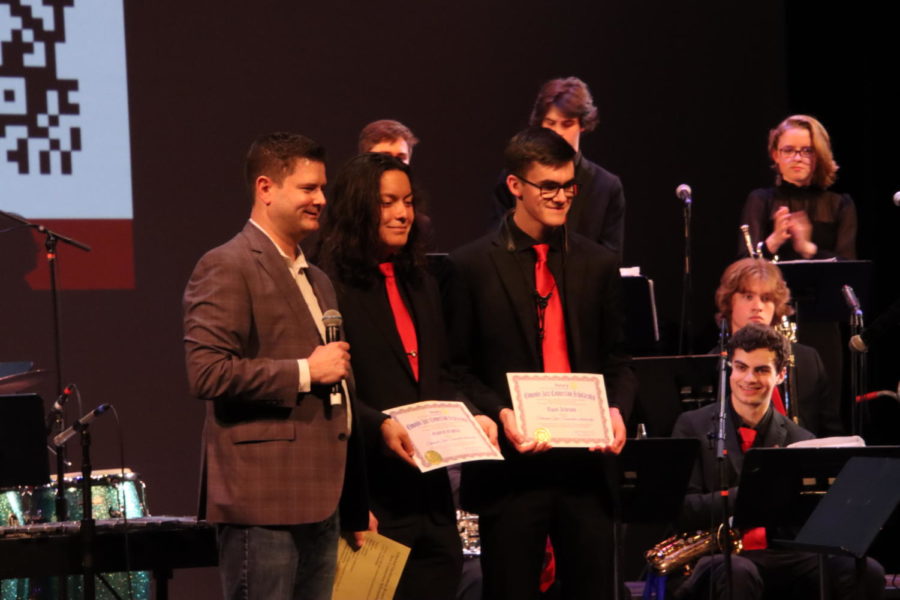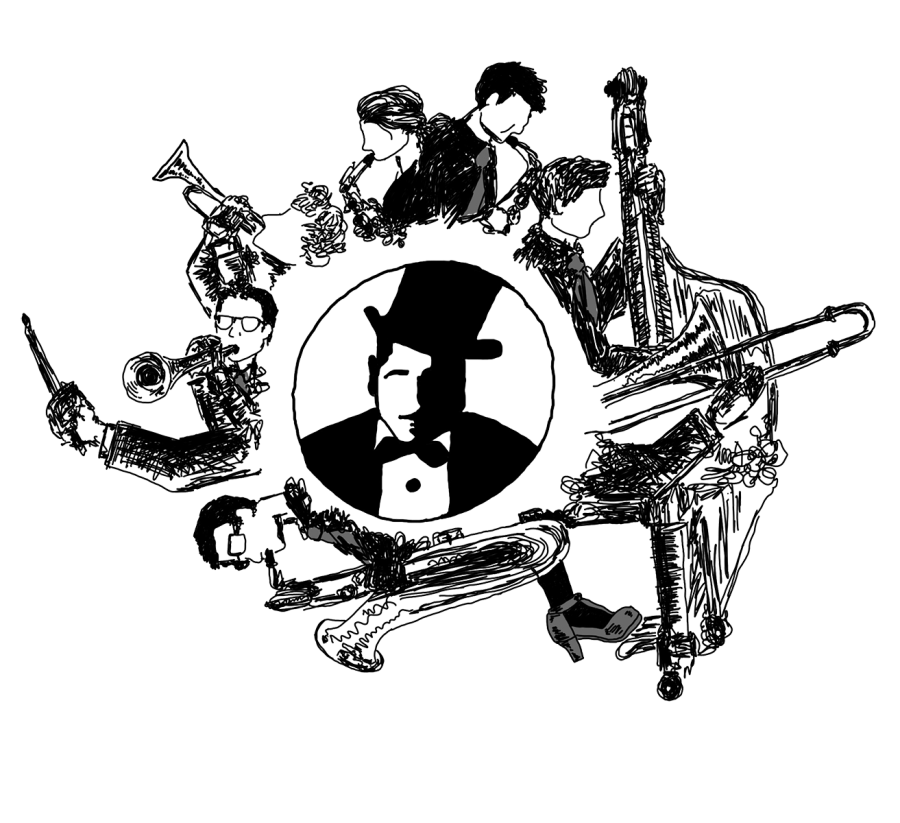The Paramount Theater has over 3,000 seats, and every March, Hot Java, Cool Jazz (HJCJ) fills all of them. Every year, elite jazz bands from five Washington high schools are invited to perform on behalf of Starbucks for a night filled with the very things the event is named after. On March 15, MTHS’ very own Jazz Ensemble 1 was one such band.
With an interior decorated in Beaux Arts style, the Baroque furnishings contrasted with the percolating caffeine and the modern guests who milled about the lobby, but the hustle and bustle backstage hinted at the golden age romance of big band performance. Despite the friendly fraternization between bands in their dressing rooms, the pre-performance jitters were palpable backstage. This sold-out show would be the largest audience many of these students had played for this year.
Faul warned them about the danger of big events, quick songs, and large venues prior to the event.
“It’s easy to play these exciting pieces and get swept up in it, and you can’t do that. You have to listen, or you’re going to have a trainwreck,” Faul said.
With this advice in mind, Jazz 1 tried to calm their nerves. They were the third band out of five, so they paced and sat around until their handler came to take them to side-stage.
In the meantime, the audience shuffled into their seats and chattered excitedly. The crowd was abuzz with anticipation for the bands. Hot Java, Cool Jazz had brought people from all sides of the community together—parents and jazz fans alike—resulting in a sold-out house and raising $700,000 split amongst the performing bands.
The first band of the night was from Edmonds Woodway High School. They opened with “Song for Bilbao” an exotic song by the Pat Metheny group. It opened with a vibraphone solo from Roni Flynn and featured Jai Lasker on the guitar, Dominic Nye on the alto sax and Anthony Edwards on the drums.
Their next song was the novelty Louis Jordan tune, “Ain’t Nobody Here But Us Chickens”, put together by their newly-formed vocal jazz ensemble (made up of instrument-playing members of the band). Guitarist Lasker, saxophonists Julia Kim and Liam Salas and trombonist Unathi Machyo, all of whom executed flawlessly layered harmonies, along with humorous ad-libs thrown in.
Finally, they played “Blood Count”, the last work of Billy Strayhorn, Duke Ellington’s longtime collaborator. It featured senior Natalie Whitlock on the alto sax, whose expressive and tender tone express the despair and anguish. Building to an intense crescendo, Whitlock demonstrated her impressive range.
Following them was Mount Si High School, from Snoqualmie. First in their set was the popular Thad Jones tune from the late 60’s, “Groove Merchant”. with a nice groove, as the name would imply, and ahead-of-its-time voicings, Mount Si’s version featured Aiden Drake on the piano, James Kolke on the trombone and an agile soprano sax solo from Christian Palomo.
Then was “When Your Smiling” as arranged by Tom Kubis. A romantic song, in a refreshing way, it featured Jackson Beymer on the tenor sax. He conveyed the kind of nonchalant fancy the song was meant to portray with his soulful licks and smooth tone.
Lastly, “Everyday I Have the Blues”, a Count Basie chart. It again featured talented saxophonist Beymer, as well as the radiant jazz vocalist Sage Eisenhour. Her vocal improvisation, large range and dynamic accents made for an incredible and memorable performance.
MTHS’s Jazz 1 took stage, and immediately launched into “Malaga,” a rollercoaster of a song with a Spanish flair written by Bill Holman for the Stan Kenton band. The dynamic structure of the song included a brief fanfare at the start, then a quiet intro that eased into a frantic main theme as well as an engrossing swing section.
Junior Josh Setala’s work on the conga provided a solid undercurrent, and senior drummer Kieran Faris’ stamina in incredible – despite the insanely quick tempo and complicated rhythm changes, he never dragged or missed a beat. It is clearly evident that he has fully immersed himself in this song.
Like Faul had said at an earlier rehearsal, “Kieran knows this tune like the back of his hand, so follow him.”
It’s certainly a song that is easy to get lost in. Malaga is full of complex polyrhythms, meaning it is hard to rely on other members of the brass or reeds for cues, which made the guidance of the rhythm section especially crucial.
Sophomore bassist Andrew Vinther’s time was impeccable, and he has grown immensely in his ability to adjust for the band’s needs and correct any discrepancies. During the performance, sophomore Natalie Song added intrigue to backings, dropping unexpected rhythmic bombs throughout.
The work by the rest of the band was stellar, too. Senior Matthew Hipolito demonstrated the often overlooked, but interesting technical, capabilities of the trombone in his opening solo. Senior Ben Leonard’s solo on the tenor sax was fantastic as usual. Thoughtful and wandering, but coming to and intense focus, his soloing style played well with the narrative of the piece. Junior Ernesto Torres gave a characteristically good solo full of energy and interesting phrasing.
The song ends blaring, a wall of sound that, even in a venue as large as the Paramount, hit the audience in the chest like a bull.
As the crowd basked in the intensity that reverberated through the room, Senior Jacob Knight walked out to the vocalist mic while Faul introduced the next song, “Feelin’ Good”.
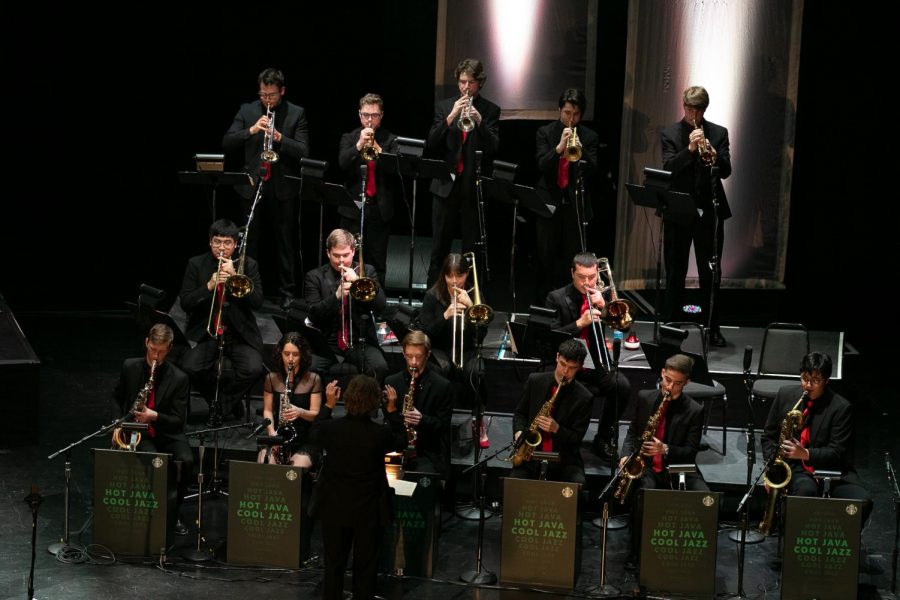
“The first time he had ever sung in public was opening night [of “Little Shop of Horrors”] and so, in my brilliance, I thought, ‘let’s trot him up in front of 3,000 people and see if he can do it again’,” said Faul, who was met with good-natured laughter from the audience.
The stage darkened, and the spotlight focused on Knight. His introspective opening verse was backed up by Faris on synth strings. Knight’s smile broadened as the audience let out surprised and enthusiastic whoops, and as the band kicked in with a raunchy, speakeasy backing.
He blew the audience away with his rich and compelling tone. His voice was resonant, his belting and vibrato carried throughout the entirety of the grand theater. Knight displayed his natural talent for expressive vocal improvisation, and impressive breath support, no doubt due to his background as a trumpet player.
The band’s accompaniment was full, and featured the talent of two extra pieces: seniors Ian Hoffbeck and Daniel Leavitt blasting on the clarinet.
The crowd loved Knight’s talent and charisma, and he soaked it in with an exhilarated smile.
“It’s crazy to think that I sang for an audience of thousands of people,” said Knight. “The best part is that people felt something… Some people said they felt chills and goosebumps.”
After the audience settled, it was time for the last piece in MTHS’s set, and the last song before intermission. It was an original composition, written by band member Kieran Faris, entitled “Cosmic Swing”. This was the third year that one of Faris’s songs have been played at Hot Java, Cool Jazz. His sophomore year, it was the latinesque “Sin Nombre”. Last year, a song out of his Japan-inspired suite, entitled “Nagare”.
For his last song as an MTHS student, Faris was inspired by prolific jazz composer Charles Mingus, and the soundtrack from the award-winning video game Cuphead: Don’t Deal with the Devil for a piece that was a good mix of classic swing sensibilities, but with an unmistakably contemporary feel. It was angular, layered, and multifaceted, as well as being flat-out fun to listen to.
It began with a graceful introduction from Song on the piano, with unexpected twists of syncopation to keep the audience guessing. Vinther’s thumping bass line was steady and constant, and the rest of the band joined, indisputably cool. The body of the song was captivating, a solid bop that made one want to move, which was exactly what many band and audience members did. The swing to it brought an element of familiarity, but the fractured feel and complex chord voicings indicated that it wasn’t just a blues anymore.
Junior alto saxophonist Caden Hargrave’s solo was probing, provocative, and expressive. Faul directed the backings to be minimalistic and under-your-breath in order to contrast with the emotiveness of the solos, and later parts of the song.
Tenor sax Leonard soared, and Faris soon joined him on his third instrument of the night, the alto sax. Faris’s tone was smooth, yet articulate, and played in a way that exhibited his intimate knowledge of the piece. Working together, their solos had an additive quality that built to a natural crescendo, ending the song in a controlled chaos that brought the audience to their feet.
After intermission, Roosevelt high school was set to play. Along with Garfield and Mount Si, they are headed to New York this May for the Essentially Ellington festival.
Roosevelt played the second Thad Jones chart of the night, entitled “The Deacon”.
Aaron Korver provided a piano introduction, which led into a swinging blues with a soulful tinge. The Roosevelt band is a large and talented group, full of creativity and skill. Will Knight on trumpet, and Nicholas Mesler on trombone rounded out the solo section on their piece.
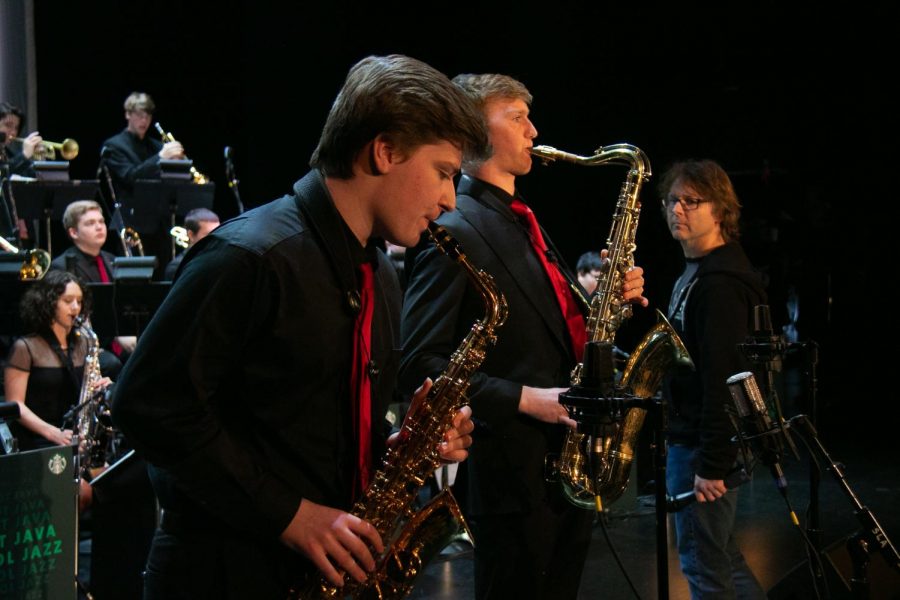
Their next piece was a Duke Ellington ballad, written in tribute to Ella Fitzgerald, called “All Heart”. It featured Carter Eng, who won the best overall soloist award at the Clark College Jazz Festival last year, on the trumpet. His style is incredibly lyrical, his honeyed tone uncommon among other trumpet players.
Their final piece was the the little-known, dream-like “Fantasm”, a Duke Ellington song arranged by John LaBarbera. Opening with an intricately articulated vibraphone solo from Nathan Mesler, and then a drum solo from Henry Moore, both of which created the mystic atmosphere crucial to the piece.
Eli Sullivan and George Fulton on the soprano and tenor saxes, respectively, gave exceptional performances, adding greatly to the mood.
Lastly, Garfield High School was ready to perform. They opened with a Bill Holman chart, called “Told You So”. A rollicking, mid-tempo swing, it sounded like a stroll on a sunny day. The Garfield band exhibited their impressive chops with a unified and professional-sounding performance. Leo Winiecki gave introduction with the piano, and Aiden Sieman and Jacob Linden soloed on the tenor and baritone sax, respectively.
Their next piece was a ballad, a variety of song that director Clarence Acox seems to be fond of. “Katie” by Sammy Nestico is a slow song, that evokes a yearning, hopeful sort of feeling. Nick Zemtzov soloed on piano, and Sam Gelpi on alto sax complemented the song with an artful solo. Garfield’s clean ensemble work made this song shine, remaining tight even in tricky split triplet sections.
Finally, a soul tune by Horace Silver aptly titled “Soulville”. With a walking bass line, shuffling drums and a bluesy feel, it featured Evan DeTurk on the alto sax, John Atwater on the trombone, Sieman on the tenor sax and Zemtzov again on piano. It was a solid choice to end a night full of talented performances.
After enthusiastic applause for all the talented students who had performed that night, band members rushed up three stories one last time into their dressing rooms, collected their instrument cases, met up with their parents and hoped that their parking meters hadn’t expired.

